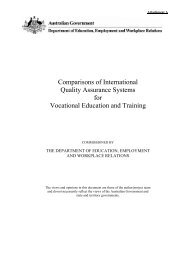Epidemics in a Changing World - Department of Innovation, Industry ...
Epidemics in a Changing World - Department of Innovation, Industry ...
Epidemics in a Changing World - Department of Innovation, Industry ...
Create successful ePaper yourself
Turn your PDF publications into a flip-book with our unique Google optimized e-Paper software.
<strong>World</strong> Health Organization<br />
IHR<br />
EpidemICs <strong>in</strong> a Chang<strong>in</strong>g <strong>World</strong><br />
Report <strong>of</strong> the Expert Work<strong>in</strong>g Group<br />
Advisory Committees<br />
IHR National Focal Po<strong>in</strong>t<br />
National Surveillance and Response<br />
National Notifiable Disease<br />
Surveillance System<br />
Communicable Disease Network<br />
Australia<br />
State and Territory surveillance,<br />
<strong>in</strong>telligence and response<br />
Commonwealth Agencies<br />
Border surveillance and<br />
response capacity<br />
34<br />
Information collection GP, labs,<br />
hospital, public<br />
Figure 6: Flow <strong>of</strong> communicable disease <strong>in</strong>formation<br />
Source: Australian Government <strong>Department</strong> <strong>of</strong> Health and Age<strong>in</strong>g<br />
Responses to <strong>in</strong>fectious disease threats to humans <strong>in</strong> Australia<br />
The Commonwealth Quarant<strong>in</strong>e Act 1908 as amended and state and territory public health law<br />
regulate the rout<strong>in</strong>e management <strong>of</strong> responses to <strong>in</strong>fectious disease threats. It is the states<br />
and territories that conduct all surveillance <strong>of</strong> notifiable diseases and launch <strong>in</strong>vestigations<br />
<strong>in</strong>to unusual events. Coord<strong>in</strong>ation <strong>of</strong> these activities is mediated through the Communicable<br />
Disease Network Australia (CDNA), supported by a range <strong>of</strong> other advisory bodies such as the<br />
Public Health Laboratory Network. The <strong>Department</strong> <strong>of</strong> Health and Age<strong>in</strong>g collates all notifiable<br />
disease data. Special collections <strong>of</strong> enteric disease data are made through OzFoodNet which<br />
has an important role <strong>in</strong> coord<strong>in</strong>at<strong>in</strong>g cross jurisdictional outbreak <strong>in</strong>vestigations.<br />
Responses to emerg<strong>in</strong>g human <strong>in</strong>fectious diseases differ from than those for animals; most<br />
powers to collect <strong>in</strong>formation and to perform public health action resid<strong>in</strong>g <strong>in</strong> the states and<br />
territories. Each has its own legislation and <strong>in</strong>dividual health systems but national approaches<br />
to surveillance and <strong>in</strong>formation shar<strong>in</strong>g have become easier with the implementation <strong>of</strong> the<br />
National Health Security Agreement. The CDNA, comprised <strong>of</strong> the jurisdictional communicable<br />
disease epidemiologists, Commonwealth representatives and other expert members,<br />
coord<strong>in</strong>ates data collections and responses and devises standard approaches to disease<br />
management. With the Public Health Laboratory Network, CDNA drafts standard case<br />
def<strong>in</strong>itions that are basic to the National Notifiable Disease Surveillance System. These<br />
networks are supported by a wide range <strong>of</strong> expert sub-committees and advisory bodies.
















